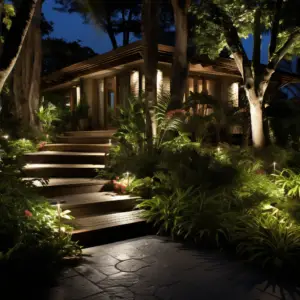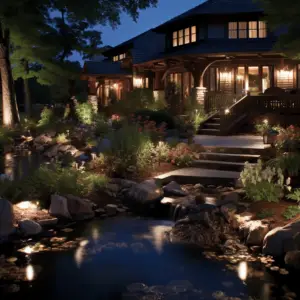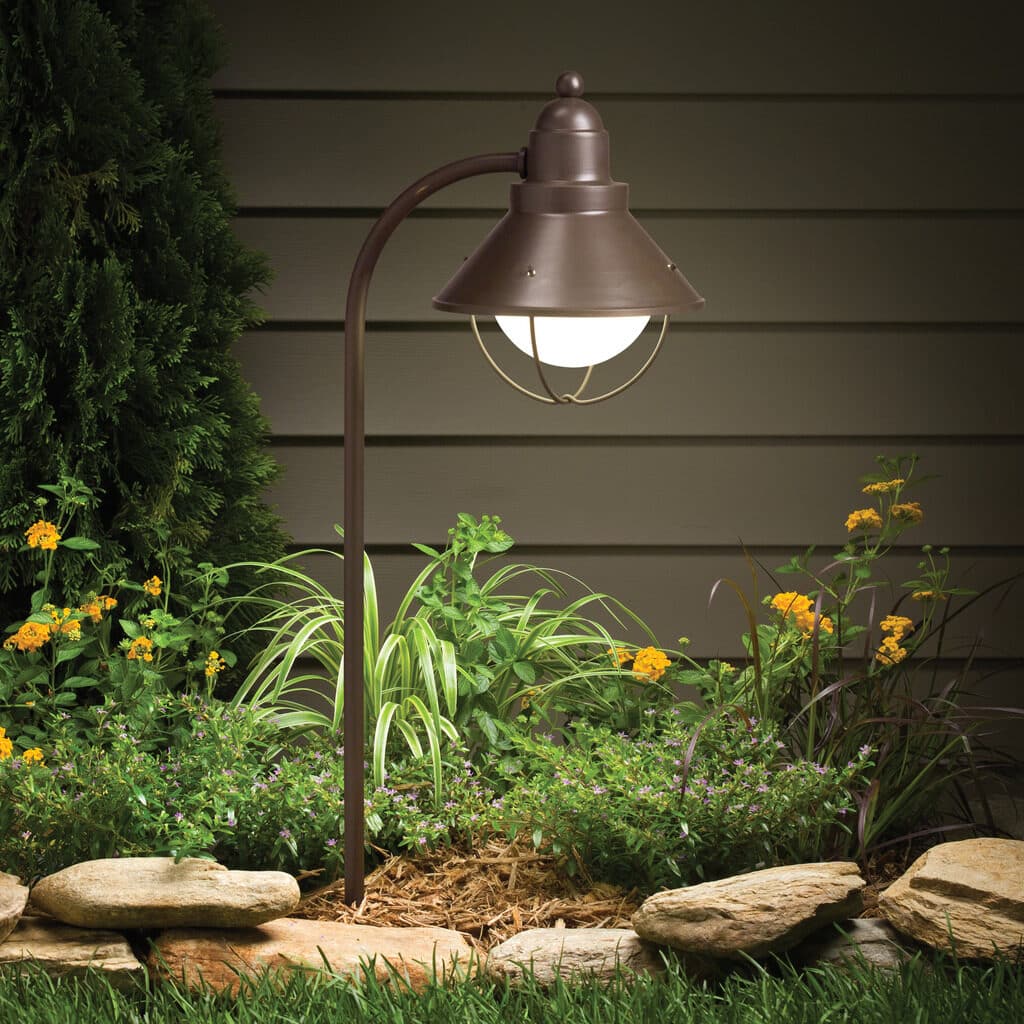Landscape lighting voltage options, It might be difficult to tell the difference between line voltage and low voltage landscape lighting, but things will get easy for you with this article. Don’t get confused; keep reading to know the difference between low voltage and line voltage landscape lighting.
For an average homeowner, it’s not easy to maintain line voltage lighting. Line voltage can also be referred to as high voltage or standard voltage. They can be used in areas such as the parking lots, outdoor security lighting, or as giant spotlights to help in illuminating bigger areas within your property.
The cost of running line voltage landscape lighting isn’t cheap. The bulbs may be large and expensive. Again, replacements are complicated; therefore, you need a reputable professional.
On the other hand, low voltage landscape lighting is better than line voltage. It uses the transformer to help in power step down and thus reduce power consumption, making it more energy-efficient.
Low voltage lighting utilizes 12-24 volts instead of 120 volts. Bulbs and other fixtures are less expensive to buy and consume less power. You may only utilize as many fixtures as your transformer’s overall wattage allows when it comes to landscape lighting.
As a result, even low-voltage landscape lighting has restrictions. Luckily, the risk of shock is significantly reduced, but the low-voltage bulbs don’t last long. They must be changed regularly.
Generally, low voltage and high voltage form the two major forms of landscape lighting. Both have advantages and disadvantages. The one you choose will be determined by a number of criteria, including the number of lights you want in your setup, your skills, pros and cons.
Table of Contents
Low Voltage Vs Line Voltage Landscape Lighting: Overview

Low Voltage Landscape Lighting (12V)
The most frequent landscape lighting option is low voltage. They are easier to install, cheap, and safe, and you don’t need to be a certified electrician to deal with them. The 12V landscape lighting reduces the risk of shock because the wiring system doesn’t need to be buried deep in the group. Again, that’s why it’s easy to install.
Notably, there is a wide array of wattages, bulbs, styles, and high-end low voltage fixtures, giving it good satisfactory performance to any customer. 12V landscape lighting is preferred and more popular than 120V landscape lighting in most home applications.
Pros
- Affordable
- Safe in wet locations
- Easy to install
- It’s safe to be used in areas where pets and children dig and play
- Cables don’t have to be in conduit
- A wide array of bulbs and lighting fixtures
- When making home improvements or rearranging the landscape, lighting fixtures as easy to relocate
- Elegant designs are available
Cons
- You need to have a transformer
- Possible dimming of the bulbs is you don’t use the cables of appropriate size
Early Verdict; Most homeowners prefer low-voltage landscape lighting for Outdoor Lighting. By a huge margin, the advantages exceed the minor drawbacks.
Low voltage landscape lighting is energy efficient and has superior safety ratings-It lower dangers of shock, works in damp conditions, and is suitable for children and pets. The two aspects make it appropriate for residential settings.
Safety and energy efficiency of low voltage lighting doesn’t rule out the usage of high-voltage landscape lighting; continue reading to discover more.
High Voltage/Line Voltage Landscape Lighting (120V)
Commercial buildings, security firms, and public utilities use 120V landscape lighting. Installing line voltage outdoor lighting takes time and an electrician.
The 120V landscape lighting line must be conduited, buried 18 inches, and connected to sealed junction boxes.
120V line voltage lighting is used in residential applications to uplight a wide canopy of giant trees or illuminate large areas with fewer but stronger lamps. The current low-voltage lighting fixtures can.
High-line voltage landscape lighting fixtures have lots of light. A series of lights’ voltage loss is typically used to explain line voltage.
Low voltage systems using modern LED technology and multi-tap transformers rarely have this issue unless the runs are very lengthy.
Pros
- Line voltage fixtures are bright thus suitable for public, commercial, and security uses.
- No chances of dimming
- You don’t need a transformer
Cons
- Expensive
- A skilled electrician is required for installation
- Connections need to be waterproof
- Cables need to be buried inside the conduit or 18 inches deep
- Large fixture
- Fewer lighting and fixture options
- Relocation and installation is difficult
- Higher chances of shock make Line voltage landscape lighting more dangerous
Low Voltage vs. Line Voltage; Which Is The Best Voltage For Your Landscape Lighting?
The winner of the Low Voltage vs. Line Voltage head-to-head comparison is Low voltage landscape lighting. However, low voltage landscape lighting is for the average homeowners.
Of course, if you want landscape lighting for commercial, security, and public amenities, you need to go for line voltage landscape lighting.
Low voltage landscape lighting is potentially the winner because its benefits outweigh the limitations. On the other hand, the high voltage outdoor lighting carrier has more negatives than positives. High voltage lighting works better in areas like parking lots and public spaces.
Low voltage has the highest recommendation if you want landscape lighting within your property. Whichever brand you select for your landscape lighting, ensure that the fixtures are made from aluminum, brass, and stainless steel to give your home’s exterior an amazing look.
Watch this video to see how the low-light landscape lighting works.
High Voltage Landscape Lights
Because of its brightness, high-voltage lighting is typically utilized outdoors in public or commercial places. It can connect several lights to one circuit and has 10 times the voltage of low-voltage systems.
Lights built for 120V require high voltage.
All cables and connections must be placed to code due to the high voltage involved, so a professional electrician is essential. Sometimes permits are needed.
Why Use Low Voltage Lighting?

Low voltage landscape lighting is a great solution for any home or business that wants to add some spooky ambiance without running the risk of electrical damage.
It provides a safer option for outdoor lighting installations as well because the lower voltage presents less risk of serious electric shock when exposed to moisture or rain.
Also, low voltage lighting has a longer lifespan than traditional voltage systems, which means you won’t have to worry about replacing your lights or upgrading them as frequently. The combination of lower wattage and LED technology is creating long-lasting bulbs that are more efficient than their predecessors: incandescent and halogen lightbulbs.
Lower voltages also allow the use of smaller bulbs, giving designers more flexibility in coming up with lighting designs. These smaller fittings are better suited for lighting small, confined spaces that would otherwise be difficult to tackle with standard-sized fixtures.
How to Install Line Voltage Landscape Lighting
A licensed electrician must install 120V line voltage. Check local construction codes and the National Electrical Code® for safety before starting this electrical project. Permits are needed sometimes.
This is required for local building codes, inspection, and certification. Before starting work, check local codes with your building department. Your electrician may suggest underground line voltage wiring. Underground installation is safer and less damaging. All subterranean cables should be in PVC conduit with continuous solvent-welded connectors. The buried cable must be 18 inches below pathways and patios and 30 inches below lawns and plant beds. Know what cable or conduit to use, how deep to bury it, and weatherproof fixtures.


